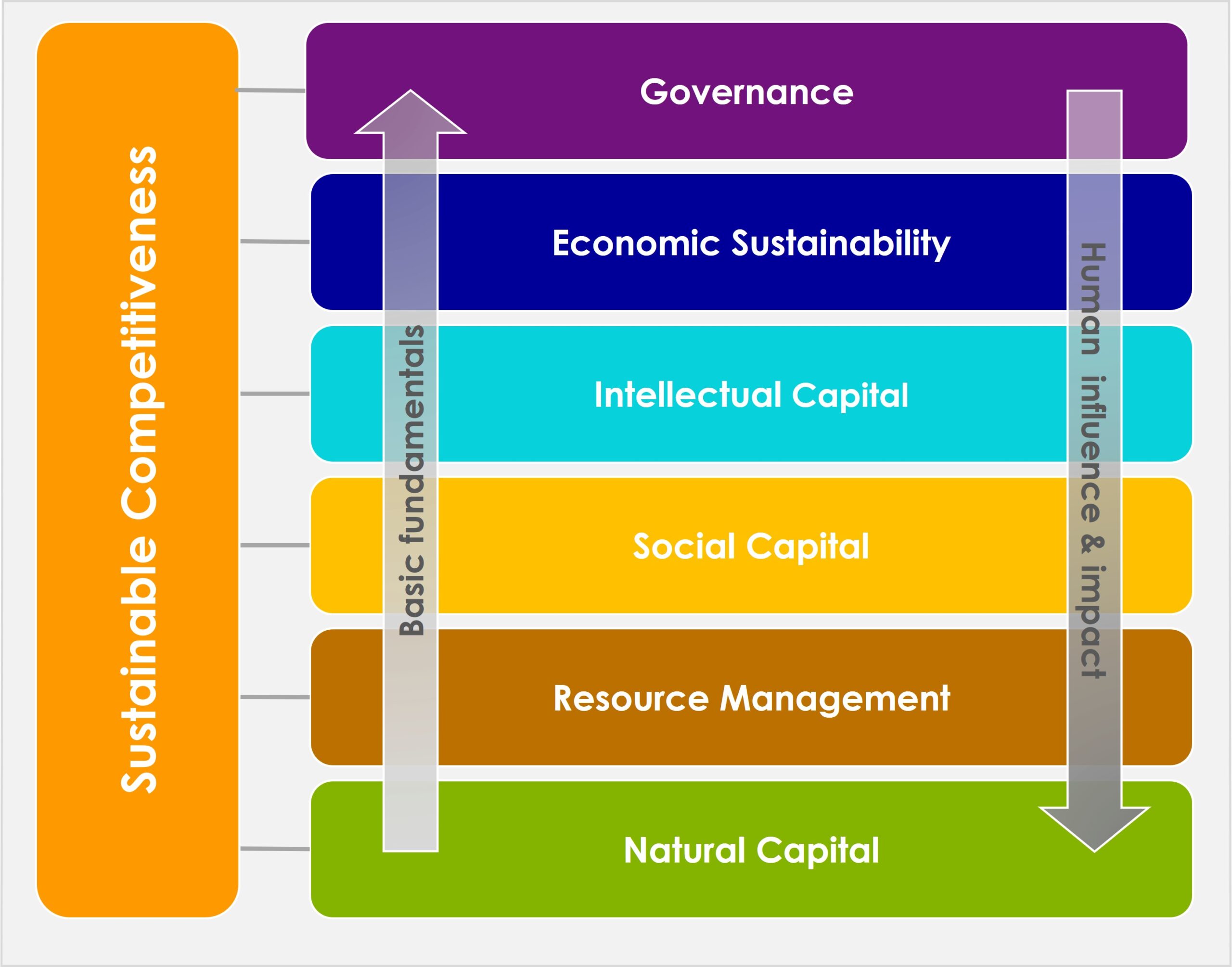
Global Sustainability Competitiveness Index
GSCI Methodology
The Sustainable Competitiveness Model
The Global Sustainable Competitiveness Index is derived from the three-dimensional sustainable development model. Reconciliation of the economy, the environment and the society is often used and applied in the corporate world to evaluate and manage sustainability issues and performance.
However, corporations are entities that operate in very different boundaries and with different goals than states and nation-economies. The elements of the model therefore have to be adapted to the characteristics of nations and their fundament of sustained prosperity.
While corporate or economic entities (depending on the nature of their business) are working with natural capital, they do not depend on the location of the capital (natural, human, financial) they utilize, and therefore can move their operations to where the external conditions are most favourable, both in terms of physical location (offices/factories) and markets, as well as in terms of business fields. Transport and international trade have made countries and people less dependent on their immediate environment through international trade of resources, including water. However, countries and population cannot simply move should fundamental resources (water, agricultural output) become scarce or the country inhabitable due to climate change. At the end of the day people rely on, and life off, the natural capital of their environment for better or worse.
The Sustainable Competitiveness Pyramid
Sustainable competitiveness – they ability to generate and sustain inclusive wealth and dignifying standard of life for all citizens in a globalised world of competing economies, consists of 6 key elements that interact and influence each other: natural capital (the given natural environment and climate, minus human induced degradation and pollution), social capital, intellectual capital (the ability to compete in a globalised market through sustained innovation), resource management (the ability to extract the highest possible value from existing resources (natural, human, financial), and governance (the framework given, normally by government policies & investments, in which a national economy operates).
It is now widely accepted that economic activities have adverse impacts or side-effects on the non-financial assets of a country. The negative impacts of economic activities – including negative impacts on the social fabric and cohabitation within a society – can undermine or even reverse future growth and wealth creation. Due to the omission of key non-financial indicators and performance that are fundamental to sustain economic activities, conventionally used measurements to measure wealth of nations such as the GDP have limited informative value for the future development of a country.
Sustainable competitiveness means the ability of a country to meet the needs and basic requirements of current generations while sustaining or growing the national and individual wealth into the future without depleting natural and social capital.
The Sustainable Competitiveness Index is built and calculated based on the sustainable competitiveness model that covers 188 data indicators grouped in 6 pillars:

Competitiveness Elements
The sustainable competitiveness model is based on a pyramid, where each level is required to support the next higher level. In the top-down direction, the different levels of the pyramid have influence the state of the lower levels.
Natural Capital
The natural capital is the base of the pyramid, and is defined by the characteristics of the given physical environment of a country. The natural capital consists of a mixture of size, population, geography, climate, biodiversity and availability of natural resources (renewable and non-renewable), as well as the level of depletion/degradation of the available resources. The combination of these factors and the level of depletion of the non-renewable resources due to human activity and climate change represents the potential for sustaining a prosperous livelihood for the population and the economy of a nation into the future.
Resource Intensity & Efficiency
The more efficient a nation is using resources (natural, human, financial), the more wealth the country is able to generate. In addition, higher efficiency means smaller negative impacts of potential supply scarcity of resources (food, energy, water, minerals). Higher efficiency is also equal to lower cost per production unit throughout all sectors, private and public. Efficient use of resources and energy is an indicator for a nation’s ability to maintain or improve living standard levels both under a future business-as-usual Indicators used cover water usage and intensity, energy usage, intensity and energy sources, climate change emissions and intensity as well as certain raw material usage. However, global data availability for raw materials consumption other than steel is limited and therefore could not be included.
Social Capital
The economy requires stability to run free of interruptions. Nations and societies therefore need a minimum level of social cohesion, coherence, and solidarity between different regions, between authorities and the people, between different interest groups, between income levels, between generations, and between individuals. A lack of social cohesion in any of the above aspects leads to social gaps that eventually lead to increased crime, violence and insecurity that can seriously undermine the stability the economy requires as a basis to thrive in the long run.
Intellectual Capital
The backbone of sustained economic success is the ability to continuously improve and innovate on all levels and throughout all institutions (not limited to the private sector). Sustaining competitiveness also requires a long-term view beyond momentary political interests or opinions, and long-term investments in crucial areas (education, infrastructure). Economies that are being deprived from investments sooner or later face decline, as some nations of the formerly “leading” West are currently learning the hard way. Indicators used for the innovation capability sub-index cover education levels, R&D performance indicators, infrastructure investment levels, employment indexes, and the balance of the agricultural-industrial-service sectors.
Governance
With the given physical environment and conditions in place, the sustained competitiveness of a country is determined by what the society and the economy is able to extract from available resources. This, in turn, is characterized by the framework provided by authorities. The framework of a country provides the basis for businesses and the social consensus. Governance indicator consist of both physical indicators (infrastructure) as well as non-physical attributes (business legislation, level of corruption, government investments, exposure to business and volatility risks, exposure to financial risks, etc.)
Data sources
Over 90% of the sustainable competitiveness indicators are purely quantitative performance indicators. Data sources were chosen according to reliability and availability of global data. The largest percentage of indicators was derived from the World Bank’s indicator database, followed by data sets and indicators provided by various UN agencies and the IMF. In addition, some recognised external indexes published by non-governmental organisations have been integrated, including Transparency International, Reporters without Borders, The New Economics Foundation, The Institute for Economics and Peace, the Fund For Peace, and the V-Dem Project.
Index calculation
Calculating scores from raw data
The raw data consist of numerical values. While values can be ranked against each other, they cannot be compared or added to other values (two apples plus three oranges are not equal to five pineapples). It is therefore necessary to extract a scalable and comparable score from the raw data as a first step.
In a second step, the relative importance (weight) of the indicator is assessed against other indicators to calculate scores for the 5 sub-indexes. The Sustainable Competitiveness Index is calculated based on the sub-indexes, each weighted equally.
Data in perspective
Raw data has to be analysed in perspective: 5000 ha of forest might be a large area for a country like Andorra, but it is a small area in China. Depending on the indicator, the denominator might be the land area, the size of the population, or intensity measurements, e.g. GDP. For certain indicators, (e.g. energy efficiency, but also innovation indicators), the performance is evaluated against two denominators (normally population size and GDP) in order to gain a more altruistic picture of the national sustainability performance that incorporates economic and human efficiency.
Trend analysis: Integrating recent developments
Current data limits the perspective to a momentary picture in time. However, the momentary status is not sufficient to gain a true picture of the sustainable competitiveness, which is, by definition, forward-looking. Of equal importance are therefore the trend developments. Analysing trends and developments allows for understanding of where a country is coming from – and, more importantly – indicates the direction of future developments. Increasing agricultural efficiency, for example, indicates a country’s capability to feed an increasing population in the future, or the opposite if the trends are decreasing.
